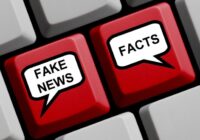What is science doing next to news, anyway? Is “science” whatever a scientist says? Is it just another buzzword politicians use to mask their motives? “News” comes from “new,” just like “information” comes from “inform,” both terms over 500 years old. In print, news usually means information about current events, ranging roughly from a small tweet (280 characters) to a long-form essay (20,000 characters). In general, the shorter the news piece and the faster it arrives, the less trustworthy it is. Some of the news we read is autogenerated by bots; some is fake.
Away from fake and fast, at the upper end of science, the laws of nature are true and eternal. But weirdly, while discovering such laws counts among humanity’s most amazing accomplishments, they are too old and boring to be news. Science textbooks are expensive and obscure. Online hosting fails the laws of nature entirely, because grand laws arrive so rarely, command less interest and are hard to monetize with advertising.
Worse is a feedback loop wherein the more society considers the hallowed high ground of science as “true,” the more valuable science becomes as a tool of persuasion, and the more monetization tries to wrest control of it. So “scientific truth” becomes even more tempting to misrepresent. As a result, there are few or no places online to find clean true useful science, unsullied by marketers, lawyers and bureaucrats.
News as Data Points
In science terms, what we call pieces of news are in fact data points, one of two crucial components in making sense of information. The other component is predictive models. Every responsive, self-regulating system feeds on data points. Your brain, your computer and your society all have to ingest data points from a changing world in chunks in order to turn it into useful information.
What kinds of data points? Brains ingest neural pulses. Markets ingest stock-transaction “ticks.” Societies ingest news articles. But two effects limit how useful those points can be. First, because quickness matters, reporters (and editors and fact-checkers) often make mistakes on deadline, so news is noisy. Further, because a viral story can make so much money whether true or not, and because “fake news” is cheaper to make than trustworthy news, more and more of news is more and more fake.
For example, during the US election four years ago, a Macedonian teenager earned 10 times the local wages by creating clickbait stories for extremist news site with the sole purpose of going viral. Fake news is very cost-effective, because it costs nothing to gather — yet it gathers more clicks. As a result, in terms of information science, media bias is real, but not toward ideology, rather toward money and power.
The fact that news can go stale and be replenished makes it an evergreen moneymaker in online media, which thrive on high throughput, agility, change and detail. But readers seldom pay online, which forces online media to grab the money first byinserting ads and popups, extra pages to create extra clicks, groveling appeals to repost/follow/like and “sponsored” (incentivized) content, all just to pay the bills. They also surreptitiously sell your reading data so that other companies can manipulate you even better. The core problem is that incentives — all incentives — mathematically corrupt trust, in direct proportion to how well they work. Incentives change things in a particular direction, while truth doesn’t change and is neutral.
So as an information source, online “news” has two structural problems: its quick-and-dirty gathering process makes the result narrow and noisy, and monetization makes it biased. Such corrupt input needs a lot of cleaning up, say with a predictive model.
Science as News
Is news about science more trustworthy than news about events? Almost never, and for all the same reasons. Most science you find in news media is, like regular news, not truth with a capital T but selected data about specific recent events, experiments and conjectures, still noisy and biased toward monetization.
The vast majority of science, and the news about it, works as follows. Scientists work for organizations with budgets and agendas. Those organizations want their research to serve those agendas (hello, incentives!), making the experiments themselves biased, even before publication. Then comes scientific publication, in which tradition, along with anonymous and often biased peer reviewers, impose obfuscated jargon, irrelevant detail and muddled explanations, ending with the obligatory weasel-worded conclusion like “this experiment might mean something, so more research is necessary.”
Such research reports are scarcely comprehensible even to specialists, much less to lay people. Reporters deal with this by speaking to the scientist who did the experiment or by merely reading digests. This quick-and-dirty reporting happens because news is time-sensitive. The result is science news that has already been corrupted by cascading steps of translation and selection optimized to boost reputation, attention-capture and revenue before it ever reaches you, the reader. At present, science news provides interesting but shaky data points, but no way to make sense of them — just like regular news.
Ideal Science
At worst, politicians invoke the trappings of science as a mask, like the meaningless dials and numbers on a COVID-19 dashboard. At best, politicians respect that scientific laws (like viral spread) are real and adopt objective metrics and data-driven targets to support human welfare. The right scientific metrics resist political and commercial tinkering, because they are transparent and obvious. The best of those metrics are based on what I’m calling ideal science.
Ideal science isn’t its gummy practice, which mixes in guesswork, experiments, mentoring and grantsmanship. Ideal science is exactly the opposite of news: old, plain and obvious. It combines experiment with mathematical law, distilling the result into the most powerful of predictive models, the universal laws of nature, like the law of gravity. These laws are so universal you don’t need to worry about the difference between Chinese and European versions. They last forever. And they predict the future, as spacecraft navigation proves. Or black holes, which were finally confirmed to be real nearly 95 years after being mathematically predicted by Karl Schwartzschild.
Prediction also drives the scientific method: First make predictions from data and models, then update the models, get more data and try again. Continually confirming predictions is also the principle brains use to explore their worlds.
What makes universal laws so potently predictive is precisely that they avoid specific details about the world and instead relate details together. The best-known laws describe relations in the physical world, including the laws of gravity, electromagnetism, quantum mechanics, heat and relativity. Of laws describing life, evolution is the best known, and on the horizon are other informational laws describing self-regulation, brains and communication. The power of such laws comes from their simplicity, as captured by idealizations such as ideal gas, absolute zero, perfect vacuum and frictionless surface. These idealizations generally appear as simple equations that can leverage data from the past into predictions of the future, the way gravity’s F = GmM/r2 guides spacecraft.
The universal law of math dominating today’s news is epidemic spread. As the separate dots of COVID-19 caseload increase percentage-wise day by day, they stay close to the predicted rising whip-like exponential curve of epidemic spread. The dots give us the curve, and the curve gives us the future. So as an idealization of how data might predict the future, fitted curves — and fitted curves alone — allow precisely smooth predictions from a few uncertain chunks. At times like now, with so many economic and social parameters so far out of kilter for months simultaneously worldwide, idealized predictive models are the only way to plan ahead. We’ve never been here before, so we need a map.
The map we seek has one new “color” (i.e. kind of natural law) never included before: the laws of information flow through space and time. Those laws are already used everywhere in technology, under names like signal processing, data science, algorithmics and computer science. The human side of those same laws includes symbolic communication, the brain’s reconstruction of 3D reality and neuromechanical trust. The extended information sciences are as close to “eternal truth” as science can get, besides gravity. They inspired most modern technology; now they can help us humans, too.
The Hyperdimensional Jigsaw Texbook
The predictive models of ideal science are what we need, but they face corruption by monetization pressures. So they can’t appear as news about science. But they might appear as science about news, in an unorthodox new form disguised as news. The base material for this new information structure would be freestanding “news” articles, each keyed to the hook of a recent event but collectively outlining universal principles, nay laws, which both precede and outlast the event itself. As if one used news about an extra-high tide to illustrate gravity in general.
Those articles together could form a tightly connected, intellectually interlocking network of mutually-supporting scientific claims, a textbook built of pieces like a jigsaw puzzle. Any motivated readers, putting them together, might solve the puzzle of the truth they seek. On the other hand, if those same readers agreed there were major contradictions, they would thereby know the whole was bunk. Even more than agreeing with experimental evidence, coherence and self-consistency among ideas mark them as coherent candidates to match reality.
If such a virtual “textbook” explained only one subject, such as economics, it would refract truth only along that axis, with few ways of cross-checking built in. By cross-linking those ideas to a different discipline, such as mathematics, cross-checking is much easier, so there is an extra axis to establish trust. By showing links between a half-dozen different quantitative disciplines — say economics, mathematics, physics, neuroscience, biology, computer science — the result (in mathematical terms) is a six-dimensional hyper-crystal, an informational structure far more solid and stable than mere three-dimensional diamond. So we can call our novel ideal-science-in-news structure a “hyperdimensional jigsaw textbook.”
Who might be the ideal creators of such a jigsaw textbook? While the voice of an author is easier to understand and more coherent, the research itself should come from multiple individuals, if only for extra pairs of error-catching eyes. Ideally those authors would ground their claims in root principles, scientifically expressed, ideally from their own synthetic works. Ideally, these authors would be intellectually independent, uninfluenced by funding or agenda. Their results should be consistent with information science and obvious in hindsight. That’s the ideal. That ideal supports human welfare by providing transparent principles, objective metrics, data-driven targets and especially a conceptually coherent framework for evaluating them. Transparency, objectivity and coherence are hard to tamper with.
Ideal Reader
Most news readers, like most news reporters, are rushed, distracted and prone to avoid dense intellectual material. They have no interest in any textbook, much less an idealized hyperdimensional jigsaw textbook. Might anyone?
Let’s imagine an ideal reader for any ideal jigsaw textbook (not just mine). Truly ideal readers of Fair Observer, of course, would so enthusiastically support the mission of diverse, unbiased, high-quality reporting to subscribe with their own money. Of those readers, the most motivated (and least busy), understanding the problems of reading on screens, would print each article out on paper because reading comprehension is severalfold better that way. They would read each printout slowly in good light and mark the paper up with questions and observations.
They would meet with other like-minded readers in person to discuss each article, enjoying the interactive bandwidth of common intention in a quiet place, and would cherish the collective “aha!” when some point resonates, or would roll their eyes when points go flat. They would make and share backup copies of whatever articles they cherish as both PDF and paper copies, so the knowledge could survive censorship, crisis or net outage. If they liked one article, they would read others since all derive from the same principles.
And most of all, they would look for conceptual contradictions, in groups to minimize their own contradictions. In any accumulating jigsaw textbook like this, as article after article comes out, each invoking similar mathematical principles across a wide range of subjects, it ought to be progressively harder to avoid bits of one article contradicting another. I claim and expect you will find no contradictions, because the truth is actually simple, and actually true. I hope you find it useful.
*[The articles in this column present a set of permanent scientific truths that interlock like jigsaw pieces. They span physics, technology, economics, media, neuroscience, bodies, brains and minds, as quantified by the mathematics of information flow through space and time. Together, they promote the neurosafe agenda: That human interactions with technology do not harm either the nervous system’s function, nor its interests, as measured by neuromechanical trust.]
The views expressed in this article are the author’s own and do not necessarily reflect Fair Observer’s editorial policy.
Support Fair Observer
We rely on your support for our independence, diversity and quality.
For more than 10 years, Fair Observer has been free, fair and independent. No billionaire owns us, no advertisers control us. We are a reader-supported nonprofit. Unlike many other publications, we keep our content free for readers regardless of where they live or whether they can afford to pay. We have no paywalls and no ads.
In the post-truth era of fake news, echo chambers and filter bubbles, we publish a plurality of perspectives from around the world. Anyone can publish with us, but everyone goes through a rigorous editorial process. So, you get fact-checked, well-reasoned content instead of noise.
We publish 2,500+ voices from 90+ countries. We also conduct education and training programs
on subjects ranging from digital media and journalism to writing and critical thinking. This
doesn’t come cheap. Servers, editors, trainers and web developers cost
money.
Please consider supporting us on a regular basis as a recurring donor or a
sustaining member.
Will you support FO’s journalism?
We rely on your support for our independence, diversity and quality.






